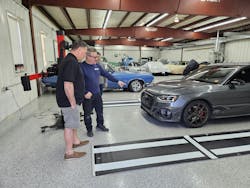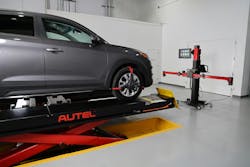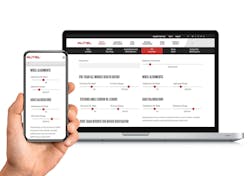Has your shop considered bringing ADAS calibrations in-house? Perhaps this is the time. With the increased number of new vehicle models hitting repair shops every day, there is a growing need to calibrate ADAS sensors. Many shops are currently subletting these vehicles to other service providers for ADAS calibrations, which not only increases cycle times but can negatively impact the customer experience and force your repair shop to either share or lose revenue.
In this second installment of our five-part series on ADAS calibration, we’ll explore why shops should consider moving ADAS calibration in-house and what that workflow looks like, from receiving the vehicle to customer delivery or pick-up. Read on as Stewart Peregrine, Autel senior executive of sales ADAS discusses the pros and cons of each path when considering ADAS business planning.
Why should decision-makers at repair shops and collision centers consider investing their time and resources to bring ADAS calibration in-house rather than subletting it out?
The ultimate goal for every collision and repair shop is to return each vehicle to the customer in the same shape as it was originally designed. This involves required safety system resets and ADAS calibrations after these sensors have been disrupted in any way. The lack of a trouble code or warning light does not mean that required calibrations can be skipped. At the end of the day, completing ADAS calibration is about providing the safest and most thorough repair for your customers. Bringing all diagnostics, including ADAS calibration, in-house means that you have control over your customer’s experience. Yet there are other paths available, each with specific pros and cons.
Can you speak more on the ADAS business planning options for repair shops and collision centers?
Absolutely. Although bringing ADAS and even full diagnostics in-house is ideal, we realize that it is not a reality for every shop. Regardless of the chosen path, you must keep in mind that your shop is liable for the entire repair, including calibrations, regardless of who performs them. Here are some options to consider.
- Working with a technology partner can potentially be the least profitable option but will allow you visibility over the entire repair. The work can be onsite — or even remote — but typically a monthly fee is required for tooling, hardware, scanning, and even personnel in some cases. Shop space will be required but cycle times can be reduced, and customer satisfaction will likely be similar to doing the ADAS calibrations in-house.
- Partnering with a mobile calibration expert requires adequate shop space and environmental conditions since the work is performed at your facility. You will have less control over cycle time, which can impact customer satisfaction. Using a mobile expert eliminates tooling and technician expenses, but you’ll also be splitting the revenue.
- Partnering with a brick-and-mortar calibration provider eliminates the shop space requirement, but vehicles will have to be transported. You will have less control of your cycle time which may impact customer satisfaction. With a brick-and-mortar partner, you’ll be splitting revenue, but it eliminates the tooling and technician expenses.
- Bringing pre- and post-scans and ADAS calibration in-house requires adequate shop space and conditions, as well as tooling and technician expenses. However, even with a modest vehicle count, this can be recouped quickly since the right technician can perform calibrations with limited training. In-house pre- and post-scans and calibrations provide control over cycle time, improve customer satisfaction, and allow you to keep most of the revenue.
- Bringing full diagnostics, programming, and ADAS calibration in-house requires adequate shop space and conditions, tooling expenses, and an experienced diagnostics technician. With a steady vehicle count, these costs can be recouped quickly. In-house diagnostics and calibrations offer the most control over the entire repair and cycle time, offer ideal customer satisfaction, and will allow you to keep all the revenue.
What equipment and coverage do you need to ensure in-house ADAS calibrations are done safely, correctly, and efficiently?
Autel offers multiple paths of entry into ADAS calibration, starting with Lane Departure Warning target and calibration packages. These can be expanded with vehicle coverage and targets when your shop is ready and can lead to all-systems ADAS using the Autel IA900AST package. The 2-in-1 IA900 wheel alignment and ADAS calibration system helps validate the repair, while the optical positioning assists the technician with accurately placing the targets. The IA900 delivers a seamless process from point A to point B.
For maximizing shop space, the Autel ADAS Bay Max vehicle lift can be highly valuable. The ADAS Bay Max performs mechanical repair, wheel alignment, and ADAS calibration in the same 32’ x 16’ shop space. An IA900 paired with a Bay Max lift maximizes efficiency in terms of workflow and shop space.
You mentioned technician training. What advice can you offer on ADAS and technology staffing?
We acknowledge that staffing for ADAS calibration can be challenging. In response, Autel continually improves the user experience by decreasing setup times with target placement assistance while also expanding and improving OEM calibration instructions in our software.
In addition, we often recommend hiring or promoting the right individual to perform pre- and post-scans and ADAS calibration. In our experience, this has less to do with an extensive automotive background and more to do with finding a candidate who is eager to learn and is able to read, comprehend, and execute instructions. Full diagnostics requires a seasoned pro, which is why Autel offers in-depth two-day technician training classes on ADAS and diagnostics as a solid way to get the right individuals ready to calibrate.
How can decision-makers and technicians most easily integrate ADAS calibration services and equipment into their store’s operations?
It comes down to researching, developing, and executing an ADAS business plan. We encourage the analysis of the risks versus rewards and the ROI and revenue potential for all options mentioned above. Speak to experts who have working knowledge and who run successful diagnostic and calibration shops. Meet with people who have already integrated ADAS calibration into their business. In terms of the return-on-investment and ADAS forecasting concerns, we suggest checking out the ADAS revenue potential and ROI calculator on the Autel website
at www.autel.cc/adas-roi.
To learn more about the simplified Autel collision workflow or to connect with an Autel ADAS expert, visit our website at: autel.com/us/adas-collision/.




